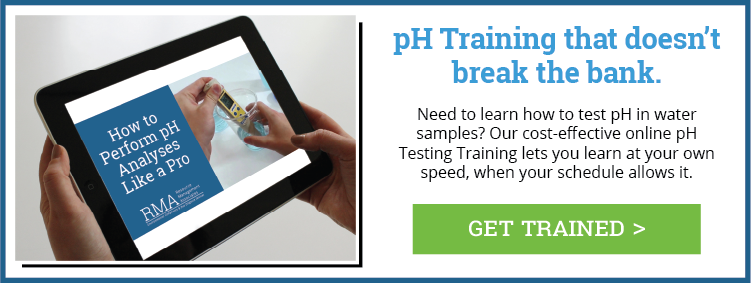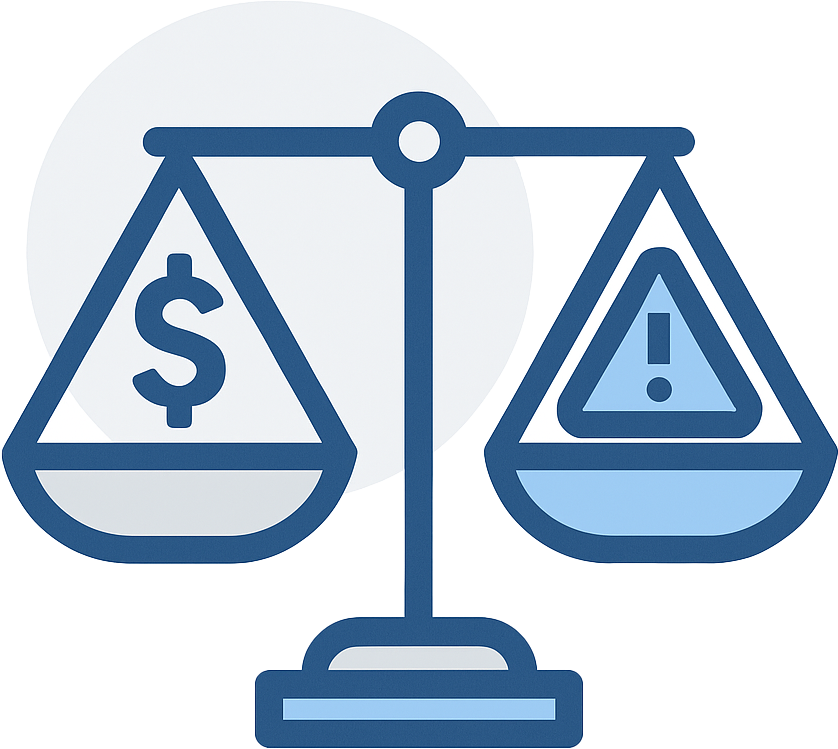Learn how to test your pH under the NCG19 Stormwater Permit for Marinas in North Carolina.
For a lot of marinas across North Carolina, life under the new NCG19 stormwater permit may be more challenging due to new requirements. One thing that has a lot of facilities scratching their head is in regard to the specific requirements regarding testing the pH of their stormwater discharge sample.
While this may have been the requirement in the past, it wasn’t clearly and explicitly stated. Because it’s now stated, in detail, within the permit, marinas are going to have to comply with this requirement, or risk non-compliance (and all the bad stuff that goes with that like violations and monetary fines).
Let’s go into some detail about this new requirement and discuss how marinas in North Carolina should test the pH of their stormwater discharge samples.
What’s new in the NCG19 stormwater permit for marinas?
Great question! In fact, we’ve been asked this so much lately, we wrote a quick-read article about it. Check it out here - A Quick Summary of Changes in the NEW North Carolina NCG19 Marina Stormwater Permit
One of the specifics in the new NCG19 stormwater permit is the language specifically stating that all testing must follow Federal testing procedures (as given at 40 CFR 136 of the Federal Register), including regarding pH testing. This means certain types of testing are acceptable while other types are not. For example, litmus strips (commonly used in pool testing) are not acceptable, while certain types of calibrated pH meters are.
What is a calibrated pH meter?
When it comes to getting the pH of your stormwater discharge, you MUST use something that meets the Federal standards for accurate measurement, which means a meter, and not litmus strips. This means that marinas must use an appropriate pH meter because it is more accurate and meets the Federal standards for pH measurement. Easier said than done because this will require some effort on the part of each individual marina. Doing your own pH analyses isn’t hard, but it isn’t child’s play either!
And not just any pH meter will do! The standards for pH testing describe that it must:
- Be “temperature compensating” (or you can do it manually which isn’t easy).
- Meet certain precision and accuracy requirements (meaning it is more accurate than a color on a litmus strip).
- Be fully calibrated each time it is used (meaning you’ll have to clean, maintain, and know how to use your equipment).
- Be used in accordance with very specific procedures (which would be outlined in a “Standard Operating Procedure” for each marina).
This all might sound like rocket science, but it really isn’t – and it isn’t even overly expensive either. For example, an entire suitable pH testing kit might run a marina around $150 - $200). We cover how to build a DIY pH Kit for Stormwater Sampling, Monitoring, or Testing in another article.
While things like pH strips are quick and easy to use, you simply can't use them if you want to stay in compliance and out of trouble! Using an accurate, high-quality pH meter at this point is your only option. Yes, it will be more costly and time-consuming, but it is the only way that a marina can meet the requirements of the NCG19 stormwater permit.

What is pH?
Just to make sure we're all on the same page here, let's quickly review what pH is.
The pH scale measures a water sample's acidity or alkalinity. Pure water has a pH of 7, making it neutral (having equal amounts of acid and base). Anything below 7 is considered an acid, while anything above 7 is considered alkaline (or basic). The juice of a lemon falls around 2.5-3 on the pH scale (acidic), while bleach is around 12 (alkaline).
Why do we have to test the pH of our stormwater discharges?
When runoff from your marina enters the water, we all know it carries stuff with it, such as sediment from along the ground. This is why when drains discharge runoff into a waterway, it often looks brown and muddy. This stuff is called a pollutant.
Just like sediment, the pH (which we can’t see) can affect water quality in negative ways by increasing acidity or decreasing alkalinity. Because of this, it is important to be able to test pH accurately and quickly.
Think about it this way - you wouldn't want to swim in water that resembled lemon juice or bleach in any way. You wouldn’t drink it, clean with it, swim in it, use it to cook, or anything else. It would be unusable. Fish, aquatic plants, microbes, and all sorts of things that survive and keep ecosystems alive and properly functioning all need a consistent pH range to live too. When the pH of waterbodies changes, it can have a ripple effect of consequences, from things like fish die-offs to rendering a waterbody unfit for consumption or recreation.
Because of this, we place limitations on the range of the pH of your stormwater discharges.
So testing the pH of stormwater samples is a new thing?
Not really. The NCG19 marina permit requires marinas to test their outfalls for pH within 15 minutes of a stormwater sample collection. This pH testing requirement has been passed on from Federal guidelines which were established long ago, so the reality is this has always been the case, it’s just explicitly explained now.

How do I test pH in stormwater samples?
The first step in testing pH is to make sure you are using a calibrated, temperature-compensating pH meter that meets required accuracy and precision standards. Our advice – read the meter’s instructions and re-read them as often as you need to in order to fully understand how to calibrate your pH meter, and how to use it! We cover one of our favorite stormwater meters out there in another article called What is the best pH meter for stormwater monitoring and sampling?
As with any measurement, there are some steps involved in order to do this correctly. Here’s an extremely brief overview of the steps involved:
- Ensure that your meter is properly calibrated. You'll do this by taking measurements of buffer solutions with known pH values, which you'll use to set (calibrate) the pH range on your meter. Buffer solutions are made to be very stable with a specific pH. These solutions can be purchased from any laboratory supply store, or even online at a place like Amazon. You should calibrate before taking your samples or conducting your analysis so that your pH meter is ready to go. If it takes longer than 3 hours between calibration and sample analysis, you’ll have to re-calibrate your meter. To make it easier, make sure your meter is calibrated and ready to use by leaving it soaking in tap water. Note that your pH meter has to be calibrated each time you use it, but not for each individual sample (for example, if your pH meter is calibrated and ready to use, you could do one or more individual samples as long as you are rinsing the pH meter’s probe with distilled water between analyses to prevent cross-contamination).
- Take your sample. Samples must be taken from your stormwater discharge points - where the water leaves your property and specifically identified within your SWPPP and stormwater permit. These samples will need to be taken within the first 30 minutes of the discharge occurring.
- Conduct a pH test right away! Make sure you get the testing done within 15 minutes of having taken the sample! If your meter is calibrated (within the past 3 hours of testing), and you’re ready to go, proceed with your analyses immediately after you’ve obtained your stormwater sample. If you have more than one sample to analyze (such as from multiple outfalls), remember to properly label them, and that you’ll need to clean off your meter (using distilled water) in between samples to ensure that there is no interference from previous tests.
- Take your pH measurements and record the results. We’re not just doing this for fun, we’ll need to record the results on appropriate forms, which will include all storm event information such as the time of sampling, your calibration data, and your final sample results, and more information.
- And that’s it for pH!
At this point, your sample will need to be sent off to a lab for analysis for other parameters. Once you get all your data back, you’ll report all the information from your stormwater sample to the state.
What can affect the pH of a stormwater discharge at a marina?
This is a great question we hear a lot. Since we can’t see pH, it’s sometimes hard to imagine it’s there, and how it can affect a stormwater discharge at a marina. Regardless, some very common things which can impact the pH of your stormwater include:
- Cleaning Products & Paint– No one likes a dirty boat! Many paints and cleaning solutions have a pH substantially different than water and can have huge impacts on the overall pH of a stormwater discharge.
- Oil and Petroleum Products – Things like gasoline, grease, lubricants, hydraulic fluid from lifts, etc., all can negatively impact stormwater discharge quality, in more than one way.
- Fertilizers & Pesticides – The stuff being sprayed or applied to the grounds of a marina, assuming the stormwater runs across these areas, will impact the stormwater quality heavily.
Just to be clear, there are additional things that may impact the pH of a stormwater discharge, above and beyond what we just listed here.
Stormwater Sample pH Testing Training
Just like other aspects of your business, you can’t (or shouldn’t) engage in certain activities without training. This rings true with testing the pH of a stormwater sample.
So to summarize, the new version of the North Carolina NCG19 marina stormwater permit clearly states that a marina’s stormwater samples must be tested within 15 minutes of collection in order to be valid, and realistically you can only use a pH meter to do so. But specifically, how do you do that?
To learn more about using a pH meter, you can enroll in our online course The Best Way to Perform pH Analyses on Your Facility's Discharge Samples, which covers everything you need to know about measuring this common water quality parameter. This quick course will get you up to speed on testing requirements, pH, and what you’ll need to do to stay in compliance with the new NCG19 stormwater permit for marinas in North Carolina.

Additional NCG19 Marina Stormwater Permit & pH Testing Information
Stormwater permits, and the regulations surrounding them, can be a lot to take in, right? If you're overwhelmed, you're not alone. RMA has been actively involved in helping companies get and stay in compliance with stormwater permits and other environmental regulations since our founding in 1992.
Our staff members have been on-site at thousands of operations across the country, so when we say we've seen it all and done it all, we mean it. We've helped everyone, from globe-spanning, multi-national organizations to small "mom & pop" operations. No matter your size, industry, or location, we'd love to learn how we can help.
So, if you're having any type of issue at your marina in North Carolina with regards to your stormwater permit and need the help of an environmental consulting firm with a proven track record, reach out. Even if we can't help, we’ll do our best to steer you in the right direction. Feel free to contact us at info@rmagreen.com, click here to contact us, or give us a call anytime at 888-RMA-0230 to learn how we can help your operation deal with environmental regulations.
Additional Stormwater Permit Information













